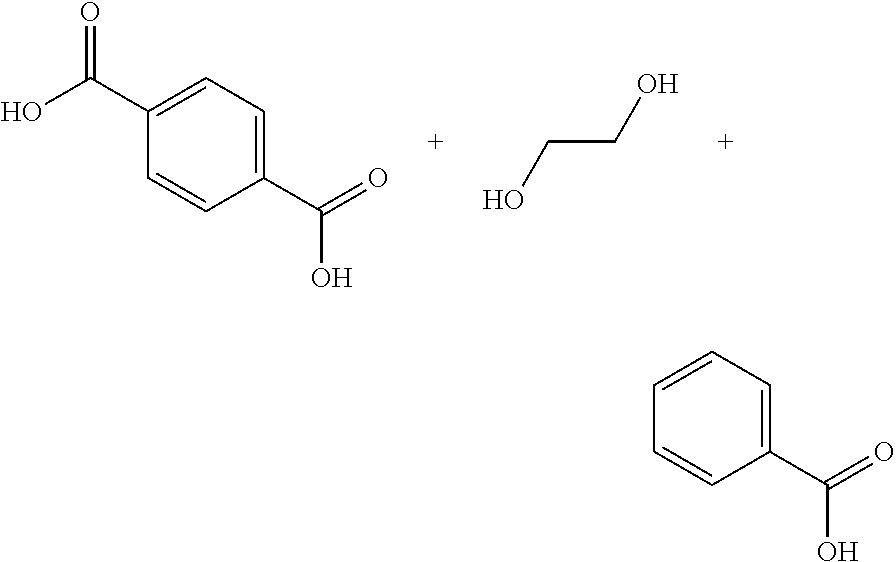Method of treating polyester textile
a technology of polyester textile and polyester, applied in the field of polyester textile treatment, can solve the problems of unsatisfactory hydrophobicity of polyester, grayish appearance of fabrics, unpleasant handle and appearan
- Summary
- Abstract
- Description
- Claims
- Application Information
AI Technical Summary
Benefits of technology
Problems solved by technology
Method used
Image
Examples
example 1
Cellulase and Cutinase in One Bath and Combined in Soaping in Launder-O-Meter
[0097]Small scaled (14 cm*14 cm) fabric of 32 s TC 65 / 35 knit was treated in Launder-O-Meter (LOM) for biopolishing. Fabric pretreatment was conducted in JFO (Werner Mathis Model JFO Laboratory Jet Dyer) and then fabric was cut into 14 cm*14 cm for polyester disperse dyeing which was carried out in Lab-O-mat (Type BFA Beaker Dyer); followed by reduction clearing and rinse; reactive dyeing of cotton biopolishing was carried out in a SDL-Atlas LP2 Launder-O-Meter (LOM) and followed by soaping. The detailed steps were explained as below:
Step 1. Fabric Pretreatment
[0098]First fabric was pretreated in JFO (Mathis Model JFO Laboratory Jet Dyer) to remove the spinning oil or scour and bleach of TC blended fabrics. 1 kg fabric was prepared to a barrel, and then loaded on the device followed by sewing to form a circle. Fabric was arranged in the cavity to make it whirling smoothly.
[0099]JFO equipment settings: winch...
example 2
Cellulase was Combined in the Reactive Dyeing and Cutinase in the Bath after Soaping (in LOM)
[0107]First the fabric pretreatment was conducted in JFO and then fabric of 32s TC 65 / 35 knit was cut into 14 cm*14 cm for polyester disperse dyeing which was carried out in Lab-O-mat, followed by reduction clearing and rinse; reactive dyeing of cotton was carried out in a SDL-Atlas LP2 Launder-O-Meter (LOM) and followed by soaping. And cutinase biopolishing on small scaled fabric was also conducted in LOM. The detailed steps were the same as steps 1-4 of Example 1.
[0108]0.6% owf Cellulase Cellusoft CRC) was combined in reactive dyeing of step 3 and 10 small steel balls were added to each beaker in LOM to provide mechanical action.
[0109]Cutinase biopolishing was conducted in the second soaping step as in step 4. It was conducted in LOM with PBS Buffer, LR=10 and Cutinase-1 of 5.6 mg enzyme protein / gram of fabric was added at pH 8 and 70° C., 0.1 g / L IPE1310 was added. One piece of fabric was...
example 3
Cellulase and Cutinase in One Bath and Combined in Soaping in JFO
[0111]1 kg fabric of 32s TC 65 / 35 knit was prepared to a barrel with 1 m in width, and then it was loaded on the device in JFO (Werner Mathis Model JFO Laboratory Jet Dyer) followed by sewing to form a circle. Fabric was arranged in the cavity to make it whirling smoothly.
[0112]Equipment setting: to set the winch speed at 12 m / min, liquor pump 70% of full capacity, to make a turn over about 28 seconds. The pretreatment, reactive dyeing of cotton part and biopolishing of 1 kg fabric was carried out in JFO while polyester disperse dyeing was carried out in Jet-dyer (ALLFIT-10). The processes were the same as steps 1-4 of Example 1.
[0113]Enzyme biopolishing was conducted in JFO with Buffer (Na2CO3-HAC, pH7), LR=10. And 0.6% owf Cellusoft CR®, cutinase-1 of 0.4 mg enzyme protein / gram of fabric was added in one bath in the second soaping of step 4. After 1.5 hour reaction, the fabric was rinsed, centrifuged, dried and then ...
PUM
| Property | Measurement | Unit |
|---|---|---|
| temperature | aaaaa | aaaaa |
| temperature | aaaaa | aaaaa |
| w/w | aaaaa | aaaaa |
Abstract
Description
Claims
Application Information
 Login to View More
Login to View More - R&D
- Intellectual Property
- Life Sciences
- Materials
- Tech Scout
- Unparalleled Data Quality
- Higher Quality Content
- 60% Fewer Hallucinations
Browse by: Latest US Patents, China's latest patents, Technical Efficacy Thesaurus, Application Domain, Technology Topic, Popular Technical Reports.
© 2025 PatSnap. All rights reserved.Legal|Privacy policy|Modern Slavery Act Transparency Statement|Sitemap|About US| Contact US: help@patsnap.com


